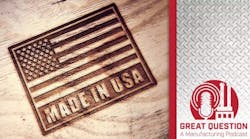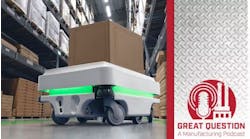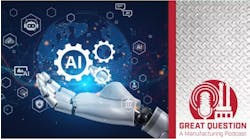Rosemary Coates is the executive director of the Reshoring Institute. She has 25 years of experience in supply chain management, operations management, project management, and systems consulting. As a seasoned executive, Coates has consulted with global and domestic clients, VCs and PE firms on operations systems and processes. She recently spoke with Robert Brooks, editor in chief of American Machinist, about how and why companies are choosing to reshore and nearshore manufacturing operations.
Below is an excerpt from the podcast:
AM: Can you give us a handy definition of reshoring?
RC: Reshoring is kind of an interesting, broader term than you would think. It includes not only bringing manufacturing back to the U.S. that had once gone overseas, but it also includes expanding manufacturing domestically, as well as foreign direct investment. So, it's got a broad umbrella and really speaks to just generally expanding U.S. manufacturing.
AM: For the readers and listeners that I'm most familiar with, that's very important. Can you tell us what is the progress report for reshoring as of now in 2024?
Podcast: The wide impacts of the Baltimore bridge disaster
RC: It's pretty positive. I'll tell you, the Reshoring Institute was established in 2014. So we've been around for 10 years, and we've seen sort of slow growth over that period of time until the pandemic. And once the pandemic hit, people recognized that these long global supply chains were very vulnerable, and every link in the supply chain had risk to it. As a result of that, so many companies across industries, not just in automotive or the places we are familiar with like semiconductors and so forth, but really broadly across all industries, are rethinking their global supply chains and bringing sourcing back to the U.S., reshoring or nearshoring their production capabilities.
AM: I'm going to come back to you about nearshoring, but is shortening the supply chain the primary factor for these organizations?
RC: I would say the primary reason is de-risking the global supply chains. As I mentioned, every time you have a link in the chain, you've got risk. You take on risk whether it's risk at the factory or it's risk in logistics or it's risk associated with higher tariff rates. Those are all specific risks. I would say the other very important component to this is that nearly everyone's agenda is sustainability and global warming. And when you reshore or you bring production closer to home, closer to your markets, you reduce your carbon footprint because there isn't so much transportation and so forth, so it goes hand in hand with restoring. Reshoring and sustainability are very closely matched. And I think, as a result, we see a lot of companies paying more attention than they were in the past.
Podcast: Accessing data and clearer paths to drive your digital transformation
You had asked earlier about growth. As I mentioned, it went fairly slowly and then took a big spike after the pandemic. It's really hard to attach numbers to it, almost impossible, and that's because when you include companies that decide never to go overseas or they're not going to pursue their previous attempt to move a factory or do sourcing overseas, that's part of what we would calculate as reshoring. And so it's not reported anywhere, for example, and it won’t necessarily be included in the numbers. So I think the numbers are actually pretty high. We see a net increase in jobs growth, but to put an actual number on it or a number of jobs, is impossible to do.



